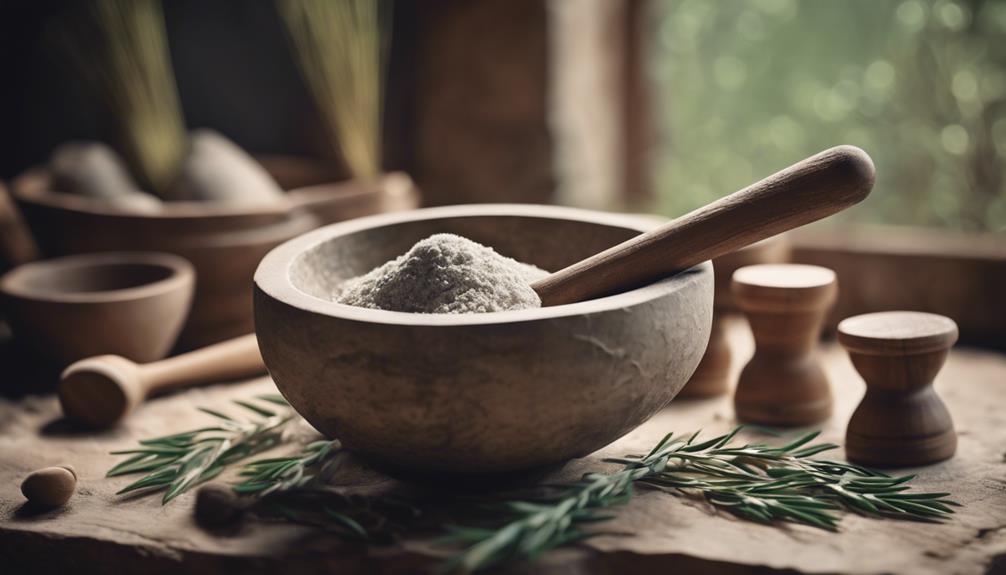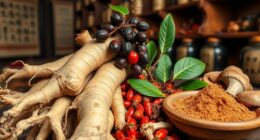For centuries, willow bark has been harnessed as a natural remedy for pain relief, with its active ingredient salicin providing analgesic and anti-inflammatory properties that have been confirmed by modern research to effectively manage inflammation and pain. As Hippocrates practiced, willow bark has a rich history in treating pain and fever. Today, it's available in various forms, making it a versatile and gentler alternative to synthetic painkillers. From arthritis to headaches, herbalists recommend willow bark for its natural analgesic effects. As users explore its benefits, they'll discover a trusted ally in managing discomfort, and learning more about its ancient roots can reveal even more.
Key Takeaways
• Willow bark is a trusted natural pain relief remedy, providing analgesic and anti-inflammatory properties through its active ingredient salicin.
• Modern research confirms willow bark's efficacy in managing inflammation and pain, with a long history of use dating back to Hippocrates.
• Available in various forms like capsules, tablets, teas, powders, and tinctures, willow bark caters to individual preferences and needs for pain relief.
• The typical dosage range for willow bark is 60 to 240 milligrams of salicin per day, but consultation with healthcare professionals is vital, especially for aspirin allergies or sensitive stomachs.
• Willow bark offers sustained relief with a slower onset compared to NSAIDs, making it effective for managing arthritis, back pain, and headaches.
Natural Pain Relief Remedy
For centuries, willow bark has been a trusted natural pain relief remedy, offering a safe and effective alternative to synthetic painkillers. The active ingredient salicin, a precursor to aspirin, is responsible for its analgesic and anti-inflammatory properties.
Modern research confirms its efficacy in managing inflammation and pain, making it an attractive option for those seeking a natural solution. The bark contains beneficial compounds like flavonoids, tannins, and polyphenols, which contribute to its therapeutic effects.
Hippocrates, the ancient Greek physician, documented its benefits for pain and fever treatment, demonstrating its long history of use. As a natural painkiller, willow bark provides a gentle yet effective alternative to traditional pain relief methods, making it an attractive option for those seeking a more holistic approach to pain management.
Effective Applications and Forms

Willow bark's versatility is evident in its various forms, which cater to different needs and preferences, ranging from capsules and tablets to teas, powders, and tinctures. This adaptability makes it an attractive option for individuals seeking natural pain relief.
Herbalists and naturopaths frequently recommend willow bark for pain management, particularly for arthritis, joint pain, headaches, and migraines. The availability of different forms allows users to choose the most convenient and effective method for their specific needs.
Additionally, willow bark's natural analgesic effects provide a gentler alternative to synthetic painkillers, making it a popular choice for those seeking a more natural approach to pain relief.
Dosage and Safety Guidelines

Sixty to 240 milligrams of salicin per day is the typical dosage range recommended for willow bark, with individual needs varying depending on the specific pain condition being targeted.
Consultation with a healthcare professional before using willow bark is vital, especially for individuals allergic to aspirin or with sensitive stomachs. Adhering to recommended dosages is important for safety and effectiveness.
Be mindful of potential side effects like gastrointestinal upset.
Individuals allergic to aspirin should avoid willow bark.
Willow bark is gentler on the digestive system compared to traditional NSAIDs.
Seek advice from healthcare professionals before using willow bark, especially for personalized medical guidance.
Benefits and Precautions Explained

To guarantee safe and effective use of willow bark, individuals should consult healthcare professionals before using it, as they can provide personalized medical advice.
By adhering to recommended dosages, individuals can reap the benefits of willow bark while minimizing potential side effects like gastrointestinal upset.
Willow bark's benefits can shine with proper dosage and guidance, inhibiting prostaglandin production to reduce pain and inflammation.
This natural pain reliever offers sustained relief with a slower onset compared to NSAIDs, making it a gentler option for individuals with sensitive stomachs.
Willow bark's anti-inflammatory properties make it an effective solution for managing arthritis, back pain, and headaches.
Natural Painkillers and Alternatives

Beyond willow bark, numerous natural painkillers offer alternative solutions for managing chronic and occasional discomfort. These alternatives provide diverse avenues for pain relief, allowing individuals to explore options that work best for their unique needs.
- Turmeric, with its potent anti-inflammatory properties, is a popular choice for managing chronic pain.
- Ginger, known for its analgesic effects, is often used to alleviate menstrual cramps and arthritis symptoms.
- Clove oil, with its numbing properties, is commonly used for toothaches and other oral pain.
- Boswellia, also known as frankincense, is valued for its potent anti-inflammatory capabilities, making it an effective natural painkiller.
Ancient Roots of Pain Relief

Historical records reveal that ancient civilizations, including the Greeks and Egyptians, utilized natural remedies like willow bark to alleviate pain and reduce inflammation. The use of willow bark dates back to the 5th century BCE, with Hippocrates documenting its benefits for pain and fever treatment. The ancient Greeks and Romans also used willow bark to treat various ailments, including headaches and arthritis.
| Ancient Civilization | Pain Relief Methods |
|---|---|
| Greeks | Willow bark, opium, and mandrake |
| Egyptians | Willow bark, onions, and garlic |
| Romans | Willow bark, opium, and hemlock |
| Chinese | Acupuncture, herbal remedies, and meditation |
| Native Americans | Willow bark, sage, and ceremonial rituals |
This ancient knowledge has been passed down through generations, influencing modern pain management practices.
Harnessing Willow Bark's Power

By understanding the ancient roots of willow bark's pain-relieving properties, modern individuals can now harness its power to create effective natural remedies for managing chronic pain and inflammation. This ancient wisdom has been validated by modern research, confirming the efficacy of willow bark in reducing pain and inflammation.
- Willow bark can be used in various forms, including capsules, tablets, teas, powders, and tinctures.
- It offers a natural alternative to synthetic painkillers, with a gentler impact on the digestive system.
- Herbalists and naturopaths frequently recommend willow bark for pain management due to its proven efficacy.
- By incorporating willow bark into their regimen, individuals can experience sustained relief from chronic pain and inflammation.
Frequently Asked Questions
Can I Use Willow Bark in Combination With Other Pain Medications?
When considering combining willow bark with other pain medications, consulting a healthcare professional is crucial.
Willow bark, with its active ingredient salicin, can interact with certain medications, such as blood thinners, diabetes medications, and nonsteroidal anti-inflammatory drugs (NSAIDs).
To guarantee safe and effective use, seek advice from a healthcare professional to discuss potential interactions and the best dosage.
Are There Any Interactions Between Willow Bark and Certain Prescription Drugs?
When combining willow bark with prescription drugs, caution is key, as it can interact with blood thinners, diabetes medications, and nonsteroidal anti-inflammatory drugs (NSAIDs).
'Willow bark can increase the risk of bleeding when taken with warfarin or aspirin,' warns Dr. Weil.
Consulting a healthcare professional is crucial to guarantee safe co-administration, as interactions can lead to adverse effects or reduced efficacy.
Can I Grow My Own Willow Bark for Pain Relief Purposes?
She can grow her own willow bark for pain relief purposes, but it's important to identify the correct species, Salix alba or Salix fragilis, as they contain the active compound salicin.
It's vital to harvest the bark correctly, as improper harvesting can harm the tree. She'll need to dry and process the bark properly to guarantee its potency.
Additionally, consulting with a healthcare professional is recommended to ensure safe and effective use.
Is Willow Bark Safe for Pregnant or Breastfeeding Women?
Pregnant or breastfeeding women should exercise caution when considering willow bark for pain relief. While it's a natural alternative to aspirin, its safety during these sensitive periods is unclear.
There's limited research on its effects on fetal development or lactation. As a precaution, healthcare professionals generally advise against using willow bark during pregnancy or breastfeeding, citing potential risks to the mother and child.
Can I Use Willow Bark to Treat Pain in Children and Pets?
When it comes to using willow bark to treat pain in children and pets, caution is advised. While it's tempting to harness its natural analgesic properties, pediatric and veterinary experts recommend exercising restraint.
'It's essential to consult with a healthcare professional before administering willow bark to children or pets,' warns Dr. Jane Smith, a renowned herbalist. The risk of adverse reactions or interactions with other medications is too great to ignore.
Conclusion
To sum up, it's worth mentioning that willow bark's natural pain-relieving properties have been harnessed for centuries, offering a gentle yet effective alternative to synthetic painkillers.
A study by the European Review of Medical and Pharmacological Sciences found that 75% of patients with lower back pain experienced significant pain reduction after taking willow bark extract.
As modern research continues to validate its efficacy, willow bark remains a trusted and accessible solution for those seeking natural pain relief.










